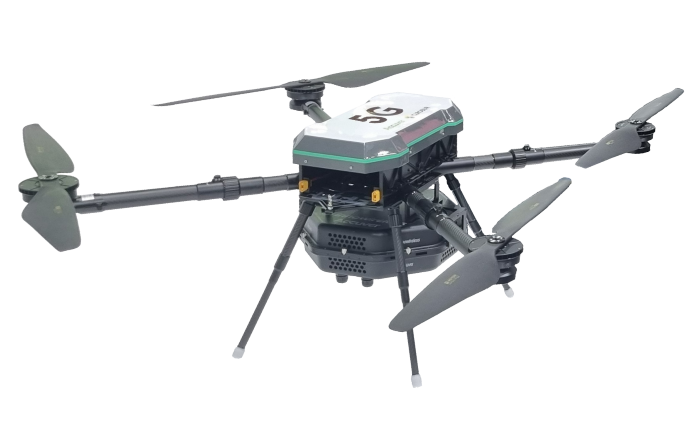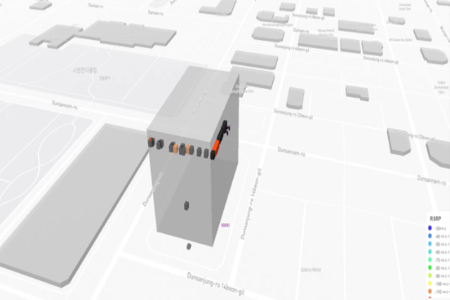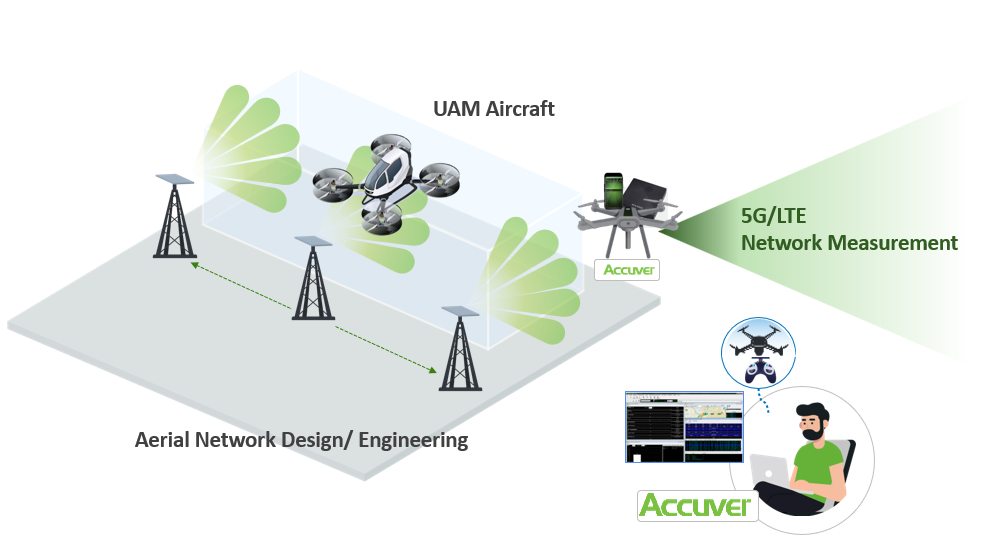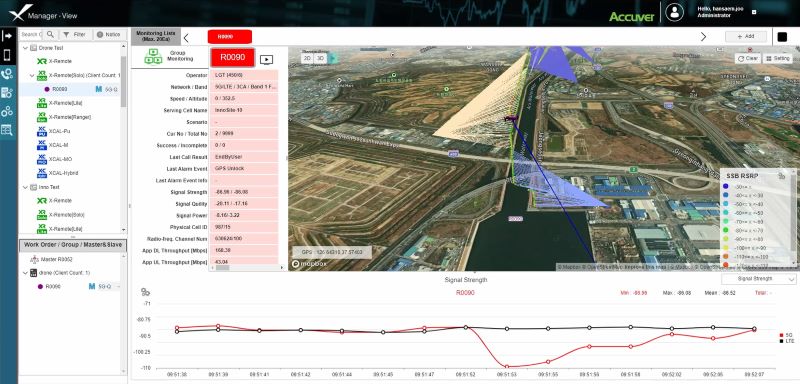XCAL-Air
Drone based 3D Airspace Network Test Solution
- Versatile and precise network test solution beyond heights
- XCAL-Air revolutionizes Mobile Network testing solutions by utilizing drones to identify and rectify coverage gaps in the air. According to the burgeoning of Urban Air Mobility (UAM) and drones, securing reliable mobile network connectivity is going to be essential even in the air.
XCAL-Air ensures continuous and reliable airspace mobile network connectivity, offering specialized capabilities.
Operators and users rely on XCAL-Air to establish and uphold uninterrupted connectivity, employing advanced features such as pre-configured flight routes, automated flights, and real-time monitoring.

Use XCAL-Air to
- Measure at altitudes of up to 600m for UAS & UAM
- Conduct benchmarking test in the airspace with up to 3 devices
- Inspect the boundary of private 5G zone to prevent undesired interference
- Perform wireless interface assessments in inaccessible locations
Benefits
- Conjunction with XCAL HW to perform network optimization
- Collect real-time RSRP on the 3D Map
- Robust containers that protect XCAL HW and devices
- The tool-free design of the container minimizes downtime, allowing for quick troubleshooting
- Gather data from a wider geographical area
Features
- Autonomous flight according to pre-defined route
- Real-time monitoring via XCAL-Manager Air
- Advanced drone control
- Mission reconfiguration in response to specific wireless network events i.e. hovering, fail-safe return, measurement extension
| Containers | XA-Network optimization | XA-Benchmarking | XA-Spectrum Analyzer | XA-Compact |
|---|---|---|---|---|
| Payload | ||||
| Usage | ||||
| Technology | 3G/LTE/5G | 3G/LTE/5G | 3G/LTE/5G | 3G/LTE/5G |
| Weight | 5.3kg | 4.2kg | 7.5kg | 1.55kg |
| Max. measurement time (independent of drone operation) | e.g. FTP test: 3h 30m (Depend on battery) | e.g. FTP test: 3h 30m (Depend on battery) | 3h 50m | e.g. FTP test: 3h 30m (Depend on battery) |

XCAL-Manager Air
XCAL-Manager Air is a server-based integrated measurement solution specialized for airspace network optimization.
It seamlessly merges collected data logs and signaling messages from XCAL-Air, empowering operators to monitor real-time measurement data, visualize statistics effectively. Furthermore, it expeditiously generates web-based reports within an hour of completing the measurement process.
Video

Library
-

- KCA′s Private 5G Site Regulating with XCAT-IXA and XCAL-AIR
- As businesses across industries embrace digital transformation and seek enhanced connectivity, private 5G networks are emerging as a powerful solution to address their unique needs. The current market size of Private 5G networks is projected to witness a remarkable growth trajectory, with a CAGR of 42.3% to 51.2% expected until 2030. Private 5G networks offer enhanced security, ultra-low latency, and guaranteed bandwidth, making them ideal for mission-critical applications in industries such as manufacturing, healthcare, and transportation. Unlike public networks, private 5G networks can be customized to align precisely with specific business requirements and use cases, optimizing resource allocation and performance.The convergence of private 5G with IoT devices, edge computing, and AI is unlocking unprecedented possibilities for automation, real-time data analytics, and predictive maintenance. [Regulatory Landscape of Private 5G in Korea] Regulatory frameworks for Private 5G networks vary across regions. Within KCA\'s multifaceted role in shaping the Korean private 5G market, \"Developing regulations and guidelines\" serves as a critical cornerstone. Key areas of regulation- Spectrum allocation: KCA defines how the limited radio spectrum is allocated for private 5G networks. This involves establishing licensing procedures, determining eligibility criteria for different types of users, and setting spectrum usage fees.- Technical standards: KCA sets technical standards for network equipment, software, and services to ensure compatibility, interoperability, and network security. This includes defining minimum performance requirements, data encryption protocols, and network management procedures.- Security and privacy: KCA establishes robust security and privacy regulations to protect sensitive data within private 5G networks. This includes data breach notification requirements, user authentication protocols, and data retention policies.- Quality of service (QoS): KCA defines minimum QoS requirements for private 5G networks to ensure reliable and consistent connectivity for critical applications. This involves setting metrics for latency, bandwidth, and packet loss.- Interference prevention: KCA takes measures to prevent interference between private 5G networks and public networks or other radio services. This may involve setting geographic separation requirements or defining power limits for network transmissions. [Accuver and KCA Collaborate to Pave the Way for Private 5G Networks]Private 5G networks are booming in smart factories, but signal interference between nearby businesses can be a problem. To ensure smooth operation and regulatory compliance, KCA (Korea Communications Agency) needed a solution for on-site inspections. Their plan consisted of three key parts:- Building a database: This database would store inspection results and statuses for different scenarios, helping KCA track compliance and identify potential issues.- Developing a dedicated inspection program: KCA wanted a program specifically designed for private 5G networks, including wireless station verification and signal strength/interference measurements.- Defining evaluation criteria: Clear standards were needed to assess the results of inspections and ensure consistent enforcement.To tackle this challenge, KCA partnered with Accuver, a technology company specializing in network testing solutions. Together, they created a comprehensive inspection protocol in 2023:Wireless station verification: Accuver\'s portable analyzer (XCAT-IXA) verified the proper configuration of network equipment.Indoor/outdoor signal measurements: XCAT-IXA was used for walking measurements, both inside and outside buildings, to assess signal strength and coverage. Outdoor interference in high-rise buildings: For scenarios where walking measurements weren\'t feasible, Accuver used a drone-based solution (XCAL-Air) in conjunction with XCAT-IXA to measure interference levels more effectively.After six months of collaboration, the efficient inspection program is ready. KCA will now report it to the Korean Ministry of Science and ICT for approval. This new program will help ensure responsible development and efficient operation of private 5G networks in Korea, ultimately benefiting businesses and consumers alike. [XCAL-Air for Outdoor interference measurement] XCAL-Air is a powerful, integrated drone-based package specifically designed for measuring and analyzing performance in airspace networks. This advanced solution combines various network equipment, including spectrum analyzers, scanners, and mobile network measurement devices, boasting a comprehensive feature set for efficient network verification in airspace environments. Thanks to Accuver\'s innovative tools, KCA can obtain precise 5G signal strengthmeasurements in the air. XCAT-IXA spectrum analyzer checks signal strength and transmits the data to the cloud. This enables them to view real-time signal strength, such as RSRP from Private 5G cells, on a 3D map, making it easy to identify any weak spots or interference. According to KCA rules, areas with an RSRP stronger than -115dBm outside the designated zone require adjustment. In the future, KCA plans to create a database of on-site inspection data for private 5G sites and manage it continuously for supervision. [Conclusion]The convergence of Private 5G with IoT devices, edge computing, and AI opens unprecedented possibilities for automation, real-time data analytics, and predictive maintenance. The role of entities like the Korea Communications Commission (KCA) becomes crucial in shaping regulations and guidelines to facilitate the seamless integration of private 5G networks.Accuver\'s collaboration with KCA showcases a proactive approach to addressing challenges in private 5G deployment. By developing a comprehensive on-site inspection protocol, including wireless station verification, signal strength/interference measurements, and interference prevention, the collaboration ensures smooth operation, regulatory compliance, and efficient management of private 5G networks in smart factories. The introduction of XCAL-Air as a drone-based solution for outdoor interference measurement further enhances the capability to identify and resolve coverage in airspace networks. Accuver\'s innovative tools, such as the XCAT-IXA spectrum analyzer, enable precise 5G signal strength measurements. The integration of these tools aligns with KCA\'s objective to create a database of on-site inspection data for continuous supervision and management of private 5G sites. Cooperation between Accuver and KCA to revitalize the private 5G Network market will continue.Accuver plans to continue developing solutions for two key markets: regulatory agencies, like the FCC and Ofcom, who require private 5G on-site inspections (similar to KCA), and engineering companies who need private 5G completion inspections.
Jan 23, 2024
-

- Accuver Airspace Network Test Solution (Korean case study)
- Airspace Network in 5G The development of a unified network infrastructure integrating Non-Terrestrial Network (NTN) platforms within the scope of 5G and future 6G technology is currently in progress. Standardization organizations like 3GPP are actively working on defining communication standards specifically tailored for Unmanned Aerial Vehicles (UAVs). Efficient performance testing and optimization of airspace networks are crucial to ensure seamless integration of communication services with UAV operations.The implementation of an airspace network in 5G technology presents unique considerations and challenges compared to traditional terrestrial networks Weak signal power from base stations to UAVs:Terrestrial networks are primarily optimized for User Equipment (UE) operating at heights ranging from 1 to 2 meters above ground level (AGL). Radio waves propagating skywards experience a decrease in signal strength compared to the ground. Establishing communication with UAVs may require the use of supplementary base stations or antenna uptilting techniques.Impact of UAV communication on ground users:Radio waves emitted by UAVs can extend to distant areas and potentially interfere with nearby base stations, smartphones, and other devices. Ensuring minimal interference and maintaining the quality of service for ground users is a critical challenge.New use cases :With the ongoing deployment of NR (New Radio) mobile networks, novel use cases will emerge as UAVs enter the market and leverage the ultra-high speed, large-capacity, ultra-reliable, low-latency communications, and multiple simultaneous connection features offered by NR.Overcoming these challenges requires optimizing signal strength for UAVs, mitigating interference with ground users, and exploring new use cases enabled by the capabilities of NR. Efforts by standardization organizations and the industry as a whole aim to address these challenges and pave the way for seamless integration of airspace networks within the 5G ecosystem.South Korea Usecase UAM Grand Challenge Korea The deployment and optimization of 5G airspace networks in Korea are driven by the objective of facilitating the commercialization of Urban Air Mobility services by 2025. To ensure a reliable and robust network infrastructure at altitudes ranging from 300 meters to 600 meters above the ground, Korean operators are employing dedicated gNBs and implementing antenna tilting and beam pattern optimization techniques. These strategies aim to provide seamless connectivity, enhanced signal strength, and reduced latency for UAM operations, thus supporting the realization of a safe and efficient urban air transportation ecosystem.Accuver Airspace Network Test Solution XCAL-Air XCAL-Air is an advanced and comprehensive package specifically developed for measuring and analyzing the performance of airspace networks. It is designed to effectively identify and rectify coverage gaps to ensure optimal network performance in airspace environments. This technologically advanced solution incorporates various network equipment, including spectrum analyzers, scanners, and mobile network measurement devices. It offers a comprehensive set of features to enable efficient network verification in airspace environments.[ Key Features of XCAL-Air ]Airspace Network Performance Measurement:XCAL-Air provides a range of powerful measurement capabilities to assess the performance of airspace networks.It captures and analyzes various network parameters such as signal strength, signal quality, throughput, latency, and other key performance indicators (KPIs) in real-time.These measurements help in evaluating the network\'s coverage, capacity, and overall performance, enabling operators to identify areas of improvement.Integration with XCAL-Manager Air:The measured data collected by XCAL-Air is seamlessly transferred to XCAL-Manager Air for further analysis and evaluation.XCAL-Manager Air is a centralized management platform equipped with advanced analytics tools, allowing for in-depth assessment of airspace network performance.Accurate Global Navigation Satellite System (GNSS) information is associated with the measured data, facilitating precise location-based analysis of airspace network performance.[ Benefits of XCAL-Air ]Comprehensive Performance Analysis: XCAL-Air provides a comprehensive set of measurements, enabling operators to gain valuable insights into the performance of airspace networks.Coverage Gap Identification: By analyzing the collected data, XCAL-Air identifies coverage gaps and areas with suboptimal network performance, allowing operators to take corrective actions.Real-Time Monitoring on 3D Map: The solution offers real-time monitoring capabilities, providing operators with immediate visibility into network performance and enabling proactive troubleshooting.Data-Driven Decision Making: XCAL-Air\'s integration with XCAL-Manager Air enables operators to perform advanced analytics and make data-driven decisions for optimizing airspace network performance.XCAL-Manager Air The XCAL-Air Ground Management System comprises two key components: XCAL-Manager Air and DROW4D. These components work in tandem to control and schedule remote tests for XCAL-Air, a specialized network testing tool designed for airspace networks. The XCAL-Air ground management system ensures efficient management, analysis, and verification of network performance.XCAL-Manager Air serves as the central control system for managing and scheduling remote tests conducted by XCAL-Air drones. It facilitates the planning and scheduling of network performance measurements in the air, based on predefined test scenarios. XCAL-Manager Air collects and analyzes the test results generated by XCAL-Air, providing valuable insights into network performance. DROW4D is an integral part of the XCAL-Air ground management system, specifically designed to control and manage XCAL-Air drones. It enables the autonomous operation of multiple drones, ensuring coordinated and synchronized flights for efficient network testing.DROW4D assigns missions to the drones based on the test scenarios set in XCAL-Manager Air, pre-configures flight routes, and controls the drones during the testing process.Key Features of the XCAL-Air Ground Management System:Real-time Network Performance Monitoring on 3D Map:The measured key performance indicators (KPIs) obtained from the network tests are displayed on a 3D map, providing a visual representation of network performance.This visualization aids in identifying coverage gaps and areas requiring optimization or further investigation.Autonomous Drone Control:DROW4D enables autonomous operation of XCAL-Air drones, leveraging real-time wireless network environment data for precise aircraft control.Advanced drone control capabilities, including fail-safe return, extended measurement functionality, and mission reconfiguration in response to specific wireless network events, are facilitated by the DROW4D system. The XCAL-Air and XCAL-Manager Air packages represent a robust and all-encompassing solution for measuring and analyzing the performance of airspace networks. With their powerful capabilities, operators gain the ability to identify coverage gaps, obtain precise measurements, and efficiently manage remote tests while analyzing test results. Moreover, the visual representation of network performance on a 3D map adds an extra layer of insight and understanding. By leveraging these comprehensive packages, operators can optimize network performance, enhance coverage, and deliver a seamless and dependable communication experience in airspace environments.
Jun 15, 2023
Solution








